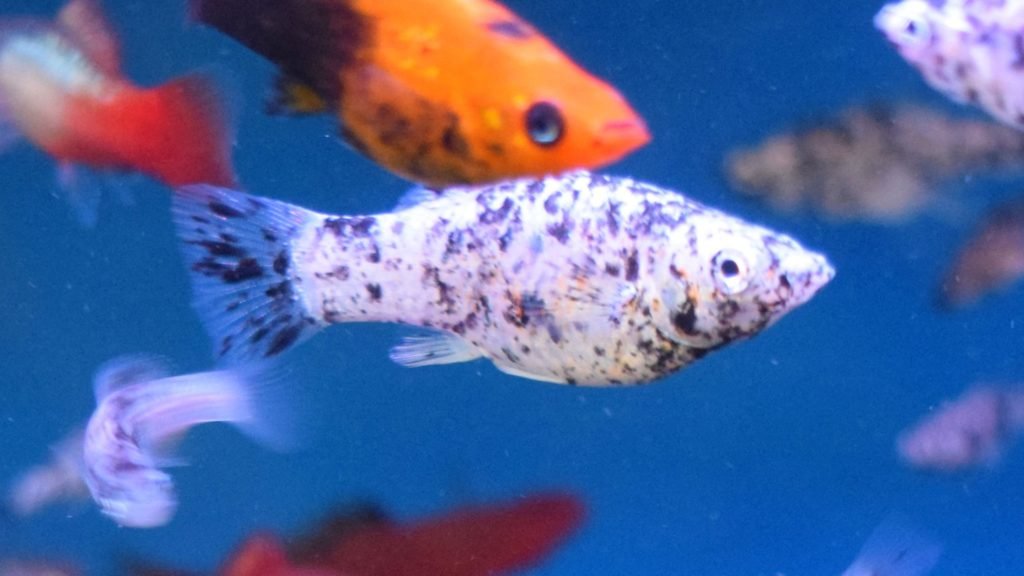Understanding Dalmatian Molly Interactions
When we talk about Dalmatian Molly’s behavior, it’s important to note that these small tropical fish are known for their peaceful and social nature. They’re not aggressive, which makes them an ideal choice for community aquariums. They love to swim around in groups and are often seen engaging in active pursuits.
Like their polka-dotted namesake dog breed, Dalmatian Molly fish display a charming blend of vitality and tranquility. But there’s more to this breed than just being the life of the party in your fish tank.
Signs of Healthy Dalmatian Molly Conduct
A healthy Dalmatian, Molly exhibits a keen sense of curiosity. Always on the move, they love exploring every nook and cranny of their environment. One of the clear indicators of their health is their consistent activity level. They enjoy swimming across the length and breadth of the tank, not hiding or sitting idle.
Eating habits are another critical aspect of Dalmatian Molly’s behavior. A healthy Molly will have a good appetite. They are omnivorous and love feeding on both plant matter and tiny organisms. If you observe a loss of appetite, it might be an indication of stress or illness.
Dalmatian Molly Social Patterns
While generally peaceful, Dalmatian Molly fish can occasionally show territorial tendencies. It’s primarily seen in males during the breeding season or when the tank is too small for the number of fish. These fish prefer a community setup and thrive when they have enough space to swim freely.
The Dalmatian Molly is a friendly species, and they enjoy the company of their kind and other non-aggressive species. However, a balanced male-to-female ratio is essential to avoid stress and aggression in the tank. Having at least two to three females per male in the aquarium is recommended.
Dealing with Aggressive Dalmatian Molly Behavior
Despite their generally peaceful nature, Dalmatian Molly fish occasionally display signs of aggression. That typically occurs when there is a need for more females, too small a tank, or insufficient hiding spots. These fish need space, and overcrowded conditions can increase stress and aggressive behavior.
It’s essential to provide plenty of hiding spots using live plants, rocks, and caves to give fish a retreat when they feel threatened. If you notice Molly being unusually aggressive, it could signify that changes need to be made in the tank environment to better accommodate their needs.
Breeding Habits of Dalmatian Molly
Dalmatian Molly’s behavior also involves interesting breeding habits. These fish are livebearers, giving birth to fully formed, free-swimming fry. A pregnant female will display a noticeably swollen belly, and it’s not unusual for them to produce anywhere from 20 to 100 fry in a single birthing event.
Males tend to be persistent, often leading to females being chased around the tank. Providing a lot of hiding spots can help females escape this pressure when needed. Moreover, once the fry is born, they should be separated or provided enough hiding places, as adult Mollies, including their parents, may predate on them.
Factors Influencing Dalmatian Molly Temperament
Several factors can influence the behavior of your Dalmatian Molly. Water quality, tank size, mates, and diet can significantly impact their demeanor. Mollies prefer clean, slightly alkaline water with a bit of salt. They’re also susceptible to changes in their environment. Hence, a well-maintained tank is vital to keep these fish healthy and stress-free.
Interpreting Dalmatian Molly Signs and Signals
Just like any other pet, Dalmatian Mollies communicate their state of health and mind through sure signs and signals. Watching them will help you understand their behavior better. For instance, a Molly rubbing its body against objects in the tank, also known as flashing, could indicate irritation or parasitic infection. On the other hand, spending a lot of time at the surface gasping for air might indicate a lack of oxygen or poor water quality.
Changes in their usual activity level, loss of color, hiding for prolonged periods, or sudden aggression are all indicators of stress or potential health problems. Paying attention to these signs and promptly addressing any issues can significantly contribute to the well-being of your Dalmatian Molly.
Dalmatian Molly Behavior in Community Tanks
As we have already established, Dalmatian Mollies are social creatures that do well in community tanks. They get along well with other non-aggressive species of the same size. However, avoid pairing them with fin-nipping species, as Mollies have large, flowing fins that can become an easy target.
Remember, even in a community tank, every fish needs its space. Overcrowding can lead to territorial disputes and stress, altering the typically peaceful Dalmatian Molly’s behavior. Consider the size and number of fish to ensure a harmonious environment.
How to Handle Dalmatian Molly Behavioral Issues
If you’re facing behavioral issues with your Dalmatian Molly, such as unusual aggression or stress signs, the first step is to reassess their living conditions. Is your tank big enough? Is the water quality optimal? Do they have enough hiding places? Are they getting a balanced diet? Addressing these fundamental questions solves many behavioral problems.
Sometimes, behavioral issues could be due to illness. Regular observation can help identify any unusual behavior early on. If your Dalmatian Molly is showing signs of distress, it might be worth consulting a vet or aquarium expert.
The Impact of Environment on Dalmatian Molly Behavior
The environment plays a crucial role in Dalmatian Molly’s behavior. These fish are hardy and adaptable but thrive best in specific conditions. A well-kept aquarium that mimics their natural habitat will see them on their best behavior.
They prefer slightly salty water, but they can also live in freshwater setups. The water temperature should be between 70-82°F, with a pH of 7.5-8.5. These conditions, a varied diet, and a peaceful environment will help keep your Dalmatian Molly happy and healthy, exhibiting the behavior that makes them a favorite among aquarists.
By understanding the Dalmatian Molly’s behavior, we can create a healthier environment for them and enjoy the lively dynamism they bring to our home aquariums. These fish are not just pets; they are companions that bring joy and vibrancy to our lives. The more we understand their behavior, the better we can ensure their well-being. After all, a happy fish makes for a happy fishkeeper!
FAQ
1. Why is my Dalmatian Molly always hiding?
Continuous hiding is not typical Dalmatian Molly behavior and might indicate stress or illness. Check the water parameters, temperature, and compatibility of tank mates. If everything seems fine, but Molly continues to hide, it might be time to consult an expert or a vet.
2. Why is my Dalmatian Molly chasing other fish?
That could be a display of territorial behavior or a part of the breeding ritual. If it’s causing stress to the other fish, you should reconsider your tank setup or the male-to-female ratio among your Mollies.
3. What do I do if other fish bully my Dalmatian Molly?
First, ensure that the fish causing the issue is compatible with Mollies. If the aggressive fish is not a suitable tank mate, it might be best to separate them. Provide enough hiding spots and ensure that the tank is clean.
4. Can changes in the environment affect Dalmatian Molly’s behavior?
Yes, Mollies are sensitive to changes in their environment. Sudden changes in temperature and water quality or moving them to a new tank can cause stress, leading to altered behavior.
5. Why is my Dalmatian Molly not eating?
Loss of appetite can indicate stress or illness. Check your water parameters and observe Molly for other signs of distress. If the problem persists, consult an expert.
Conclusion
Understanding Dalmatian Molly’s behavior is fascinating and essential for their well-being. These delightful fish are a joy to watch and a great addition to your home aquarium. By paying attention to their behavior and ensuring optimal living conditions, you can enjoy the company of these lively, polka-dotted swimmers for many years. Remember, a happy and healthy Dalmatian Molly is active and interactive! They bring life and vibrancy to your tank and, in turn, to your life. So, keep observing, learning, and enjoying the beautiful world of your Dalmatian Molly!
Related Articles

Mastering the Art of Dog Training: How to Train Your Dog to Stop Barking
Introduction to Dog Barking Barking is an

How to Clean Goldendoodle Ears: Preventing Infections
Welcome to our essential guide on how

Top Picks: Best Harness for Goldendoodle Revealed!
Welcome to our comprehensive guide on finding

Insider Tips for the Perfect Goldendoodle Diet
Struggling with your Goldendoodle’s diet can be

Goldendoodles Grooming: The Ultimate Toolkit for Perfect Care
Table of Contents Welcome to the world

Discover the Perfect Dog Nail Grinder for Your Furry Friend
Finding the ideal dog nail grinder can be daunting

